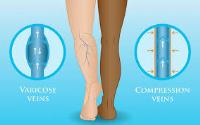
Varicose or Spider vein, have you heard of any of these two vein diseases? Here is an article for you to read on the varicose vein, spider vein and compression socks. With several veins in the body, and you may wonder which one exactly is a varicose vein. The varicose vein is not specific to a particular vein; instead, it depicts twisted and enlarged veins. The veins found in the leg region are more prone to becoming varicose.
Several symptoms experienced by patients diagnosed with varicose veins include knee ache, inability to sit for extended periods without feeling pain, and burning sensations. Information about compression stockings for varicose veins and its benefits will be discussed extensively in this article.
Varicose Veins Symptoms
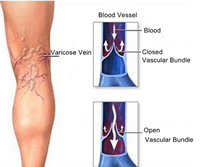
In recent times, the occurrence of vein-related problems has become a prevalent chronic condition in the United States. According to statistics, about 40 percent of the population in the US is at risk of being affected by a condition known as chronic venous insufficiency, which often leads to more severe issues, one of which is varicose veins.
People with this condition often experience heaviness on the legs with swollen ankles in the end. There’s every likelihood that they may have pains or night cramps in their legs.
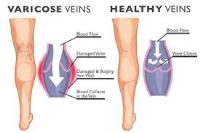
When the valves present in your veins get damaged, these symptoms are likely to occur. It makes healthy blood flow to your legs very difficult, and this, in turn, affects blood flow to your heart. The result of this is the pooling of blood around the calves and ankles. Over time, these unresponsive valves can lead to varicose veins, rope-like, twisted veins of purple or bluish color, usually visible under your skin.
If you’re affected by some venous conditions or related symptoms, these varicose veins compression socks can be beneficial.
Why you should use compression socks
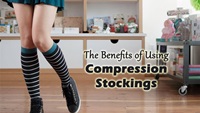
These compression stockings are classified as a special kind of elastic hosiery which functions to assist in blood circulation in the body and prevent different health conditions which include:
- Chronic venous insufficiency
- Spider veins
- Varicose veins
These stockings put pressure on your ankles and legs, compressing the veins and arteries at the surface, and helping the valves at the venous valves function well, and assist in blood flow back to the heart without hindrances.
How to use the compression stockings

It’s essential to have these compression stockings on, preferably in the morning before you bring down your legs and get out of bed.
Taking a horizontal sleeping position helps your valves function efficiently, better than when standing or sitting. When you’re in a vertical position, the force of gravity steps in, compromising blood flow as a result of the valves that are damaged, this explains why your calves and ankles feel okay in the morning. Still, as the day progresses, they become heavy and swollen.
Having these compression socks on in the morning keeps your valves in place in the right position to enable healthy blood flow properly in your legs during the day.
If you already have a vein-related condition, these compression stockings for veins can be useful in getting rid of symptoms which include:
- restless legs
- heavy or aching legs
- Pain and fatigue
- swelling of the ankles
- night cramps
These compression stockings provide many benefits and are particularly useful in conditions that intensify these venous conditions;
- Prolonged standing or sitting
- Traveling for an extended period, using flight or other transport means without sufficient space for the leg
- Pregnancy
Studies have shown that compression stockings at calf length can be used to prevent and reduce swelling in the evening. Researchers recommend these compression stockings for people who sit or stand for long periods.the day as a result of their job or profession.
Which type of compression stocking should I use?
The choice of the best kind of stocking to use and the appropriate amount of pressure is dependent on the type, number, and the leading cause of the individual’s varicose veins.
The three main types are:
Support pantyhose

They exert pressure but are the least to be considered in security options.
Compression socks and stockings

These offer a wide range of pressures and can be purchased easily at the pharmacist, drug stores, and online stores. They provide more support than pantyhose.
Prescription compression socks
This group exerts the highest amount of pressure. They are fitted by a specialist to ensure effectiveness, but they are not very tight, therefore cannot affect circulation in a person. Typically, compression socks are either knee or thigh-high — knee-high stockings that aid circulation around the lower leg, most notably during exercise. Likewise, thigh-high compression stockings for varicose veins may be recommended by a medically trained professional as they are often used to prevent a situation of blood clotting after surgery, most notably after a chronic knee replacement surgery
When should I wear compression stockings
People often wear these compression stockings during the daytime, mostly because there’s every tendency to have circulation problems after sitting upright and standing for too long.
An individual with varicose veins may decide to put their feet up, especially during the night, to help with blood circulation. Nevertheless, doctors may recommend wearing stockings at night too.
Similar Articles on ComproGear
- Sock Soothers
- Compression Sleeves for Legs
- Medical Compression Socks
- Calf Compressors
- Compression Socks for Men
- Best Compression Socks for Swelling
- Doc Socks
- How Tight Should Compression Socks Be
- Best Compression Socks for Swelling
- Doc Socks
- Compression Socks Good or Bad
- Wide Calf Compression Socks
- How Long Should You Wear Compression Socks
- Can You Wear Compression Stockings 24 Hours a Day
- Footless Compression Socks
- Toeless Compression Socks
- Thigh High Compression Socks
- Sock Soothers
- Do Compression Socks Help Gout
- Easy To Put On Compression Socks for Elderly
- Zipper Compression Socks
Choosing the right size
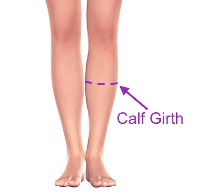
Choosing the right size of compression stockings for the varicose veins is often one of the toughest decisions for most people. It is crucial to select the right size to guarantee comfort and ease, helping you take advantage of the enormous benefits of using this elastic hosiery. To ensure the compression stockings fit correctly, take measurements. Below are a few helpful tips:
- Take accurate leg measurements before you lower legs or even step out in the morning.
- Measure the narrowest area in your ankle and the fullest part of your calves. This applies to knee-high socks. Next, sit up on your bed, putting your feet on the floor, and bending your knees to form a 90° angle. Take measurements between the level and bent knee of each leg.
- For thigh-high stockings, the routine is almost the same, but in this case, take measurements for knee-high socks. Then stand up and measure your thighs under your buttocks. Lastly, measure the distance between the floor and your buttocks.
- It is often very tricky to take these measurements. Therefore, don’t be shy or afraid to seek help or consult your doctor if you have doubts.
How to choose the appropriate compression level
Always seek advice and consult your doctor about the decision to get compression socks to enable you to choose the right compression level. Four primary levels of compression:
- Mild compression: This can be used in a situation where you have a slight chronic venous deficit to aggravate healthy blood flow and enable your legs to feel lighter.
- Moderate compression: This is more effective and is recommended for patients who are experiencing symptoms of the spider or varicose veins.
- Firm and extra-firm compression: A doctor often recommends these in severe cases of venous diseases, including leg ulcers, lymphatic edema, and deep vein thrombosis.
How to take care of compression stockings
It’s not so challenging to take care of your compression socks. However, there are a few things to have in mind for them to last as long as without losing its benefits and strengths.
- Use cold or mild temperature water.
- Hand-wash your stocking, don’t use a washing machine.
- Don’t use fabric softener. Use only mild detergent or soap.
- Hang your stockings to dry, never use a dryer.
Compression socks and stockings don’t necessarily prevent the growth of varicose veins and spider veins. Nonetheless, they work as an excellent support mechanism for healthy blood flow and reduce the symptoms of varicose veins that bother, especially when the socks are worn for a long time. Always discuss with your doctor or health professional when you want to wear compression stockings.
Can varicose veins be prevented?
The development of varicose veins can be attributed to different reasons. Risk factors of varicose veins include family history, age, pregnancy, being a woman, obesity, contraception therapy or hormonal replacement, sitting, or standing for long hours, amongst others. Some of these factors, like age and family history, are somewhat difficult to avoid than others. The question now is, Is there a way to prevent the formation of varicose veins?
Unfortunately, the answer to this is no, but you can prevent the worsening of existing varicose veins. Living a healthy lifestyle helps you delay venous problems for as long as necessary. Here are a few helpful tips.
1. Avoid sitting or standing for long periods
Maintaining a particular position in sitting or standing makes the travel of blood in the leg veins more difficult against gravity. This results in increased pressure in your veins. Eventually, a blood pool is formed around your ankles, with your feet and calves getting achy and swollen.
That said, movement decreases venous pressure and improves blood circulation. If your job requires sitting at a desk for long periods, do small exercises, like
- Peddling your feet
- Stretching your ankles
- Bending your knees like you’re marching.
- Elevate your legs for at least three times daily, 15 minutes each time. Raising your feet above your heart helps break the circle of gravity. The result of this is increased blood flow and less swelling at the ankles.
2. Wear compression stockings
Compression socks help keep your vein valves in their appropriate position. It becomes a lot easier for proper functioning and reduction of blood pooling, swelling, and pain as well.
It’s very healthy to experience cramps at night after wearing supportive compression socks. There are different types of compression levels, and this is dependent on the extent of damage to your veins. It’s always a good idea to speak to your physician when choosing a compression from the full range of options: mild, moderate, firm, or extra firm.
3. Live a healthy lifestyle
The development of varicose veins is often attributed to the risk mentioned above factors that you can’t change. It is, therefore, essential to practice healthy living and leading a healthy lifestyle to prevent more venous damage. One major aggravating factor is obesity, with increased pressure on the veins.
Taking a healthy diet rich in. Complex carbohydrates, healthy fats, an adequate amount of proteins is utmost. Avoid consumption of foods high in salt. Instead, take feeds with high fiber and potassium constituents. Ensure to bring enough water during the day; remain hydrated as proper hydration makes for healthy blood circulation.
4. Make exercise part of your routine
Walking is the most beneficial exercise to prevent the development of varicose veins. Another great option is yoga. You can make it more interesting by trying out different poses that make your feet higher than your heart. These are referred to as inversions, and they include a headstand, shoulder stand, and Legs-Up-the-Wall Pose.

Yoga helps tone and elongate the deepest muscles in your calves and hamstrings. To a certain degree, these deep muscles are capable of assisting these valves in functioning correctly. Stretching and firming poses include the Downward-Facing Dog Pose, sun salutations, and most forward-bend poses. Other types of exercises that could be of benefit are cycling and swimming.
5. Sleep positions for pregnant women
One major cause of varicose veins is pregnancy. Formation of varicose veins can be prevented by sleeping on the left side, easing the symptoms of already existing varicose veins. Sleeping in this position helps reduce pressure from your expanding uterus in the big thread in the pelvic area, located on your body’s middle right side.
Conclusion
Vein valves tend to become weaker with time resulting in the worsening of varicose veins. You can’t influence the risk factors like gender, age, or even family history. However, following a healthy diet, exercising regularly, staying adequately hydrated, and maintaining healthy blood pressure is undoubtedly within your control.
This page last updated January 8, 2022
